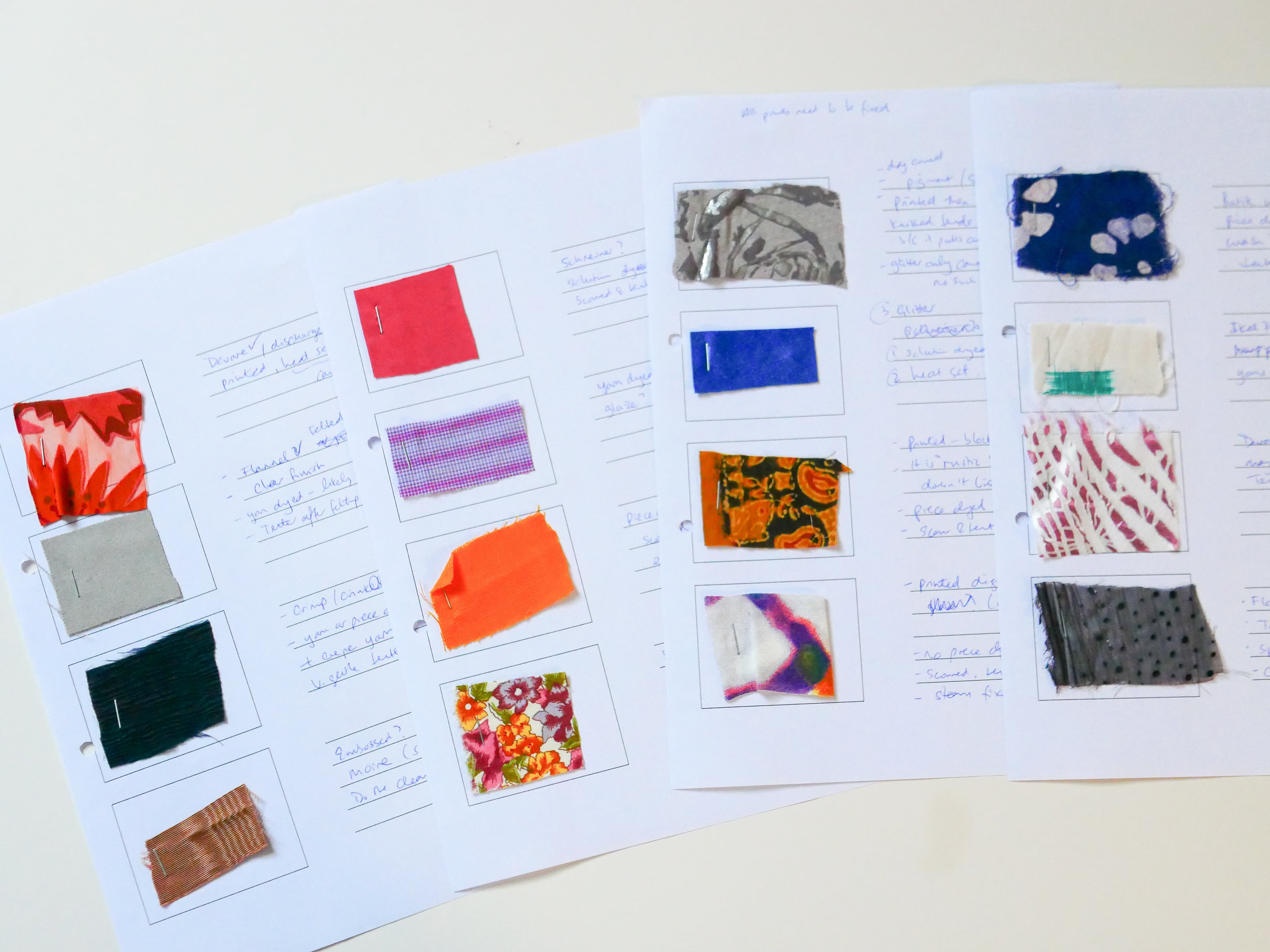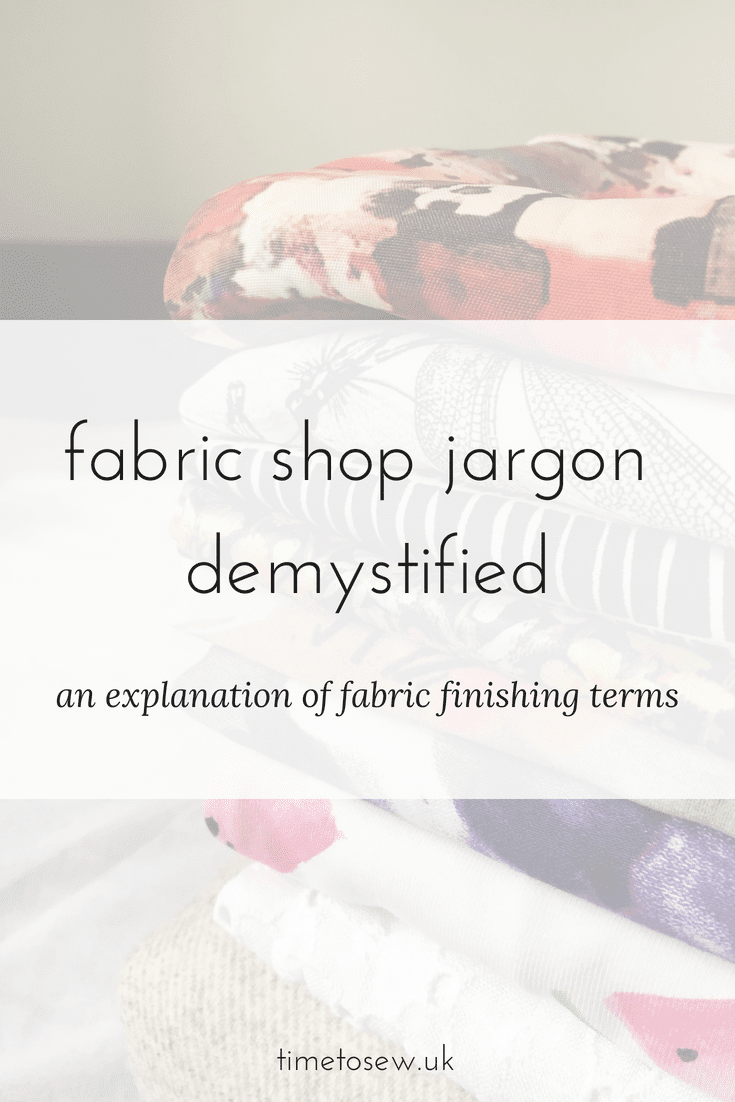Have you ever wondered whether some of the terms used in fabric shops actually mean anything fancy or special? Being a bit of a textiles geek, I’m really interested in understanding how fabric is made and what processes it has been through. Recently I did a workshop on dyeing and fabric finishing. Part of it was spending quite awhile looking at samples of what might win the awards for ugliest fabric ever, and trying to figure out what had happened to them during manufacture.
Fabric finishing: chemical or mechanical that are applied to fabrics to give them certain properties or change their look and feel.

In the workshop I got to ask all the questions about what the terms meant. I have compiled a list of the ones often seen online. Please tell me if the explanations don’t make sense! I’m also going to do a part 2 post on weave types (e.g. satin, lawn vs poplin etc), what they actually mean and how they look.
Fabric Finishing terms
- Mercerisation: for example mercerised cotton. Named after the inventor John Mercer who developed the treatment (applies only to cotton). Fabric is put into a bath of sodium hydroxide to make it stronger, more absorbent, and more receptive to dyeing. It also gives it a nice lustre. You might know sodium hydroxide as caustic soda, the stuff you use to clean drains. It is also used in the viscose production process, which I discussed here.
- Sandwashed: for example sandwashed silk. Washed with coarse sand to make it softer with a subtle suede like texture.
- Stone washed: for example denim. Washed with pumice stone (the kind you use on your feet) to give a faded effect. Enzymes can do a similar thing.
- Enzyme washed: often seen in denim (sometimes linen).
- In denim enzyme wash, cellulase (the enzyme) reacts with the cellulose (carbohydrate in plants that gives them stiffness and strength) and weakens the surface fibres of the denim. The washing breaks off the fibres and takes the dye with it, so you end up with a faded / softening effect.
- It’s seen as a more eco version of stone wash. For example, the amount of enzymes required is small compared to the amount of stones needed for the same thing. There is also a water saving from not having to wash off the stones. Final benefit claimed is that there are no harsh chemicals used.
- You’ll also see enzymes in “biological” laundry detergent. They react with fats etc. to remove the stains. But they can also be irritating to skin so you can also get “non biological” detergent which is recommended if you have babies.
- Washed denim / linen: what it says on the tin, nothing special here.
- Antibacterial, anti static, anti crease: these are chemical finishes and they will wash out! I have it on good authority that a finish like anti crease (or easy care / no iron) is designed to last about 20 washes. So what you buy is not precisely what you will get a year down the line!
Fabric classification terms
- Brushed or combed cotton: fabric goes through rollers with wires that pull at the surface in one direction. This gives it fuzziness. You will often see this used for pyjamas in winter.
- Laminated fabric: two layers stuck together with an adhesive (note: double faced fabric is stitched together).
- Seersucker fabric: the crinkle comes from the fabric being printed with sodium hydroxide. This shrinks the fibres that it touches which makes the fabric pucker. You can have whatever crinkle patterns you want.
- Woven stripe fabric: stripes are woven in the fabric using different coloured yarns (i.e. it is yarn dyed, see below on dyeing). This is as opposed to printed, where you would start with a base of a plain fabric and print on a stripe design.
- Eco fabric: this is made up, there is no such thing and anyone labelling a fabric like this is probably greenwashing you. Each fibre comes with its goods and bads. There is no single global standard of the sustainability of fibres! A value judgment is always made somewhere, whether its carbon emissions, water etc.
- Organic fabric: see my FAQs here.
Dyeing terms
- Hand dyed: what it says on the tin, a human did the dyeing rather than a machine in a factory. I imagine this would only happen for small quantities!
- Yarn dyed: nothing fancy. Just means the yarns (or threads) are dyed different colours before being woven. You’ll often see this in stripes or ikat patterns.
- Hand block: a design has been engraved into a wooden block and the pattern is manually stamped on the fabric. Same principle as using stamps and ink pads at home for crafting (especially with kids). Often seen in ethical fabric shops.
- Non azo: this is a type of dye used for natural fibres such as cotton and linen. However some of them can be carcinogenic. The GOTS certification prohibits azo dyes to be used.
—
That’s it for now, I hope that was useful. If you have other terms you’d like to know about, let me know and I’ll do my best to find out and add to the post!
PIN FOR LATER:



14 comments
This is super helpful and handy, thank you! Pinned it straight away.
Glad it was useful to you! Thanks for pinning 🙂
I’m so glad you’re such a “textiles geek”, Kate! And so glad you’re sharing your knowledge with us. Such an informative post. Thank you.
Thanks Lori, you are very welcome! More to come…
Thank you Kate! You have filled in a few holes in my own fabric geek knowledge ???? Please keep these posts coming xx
Glad you enjoyed geeking out with me, and yes I’ll do my best. More to come!
Really helpful thanks. I’m shocked by the anti bacterial & anti crease claims as they are used in shorts wear lingo a lot.
I’m not surprised by the eco friendly fabric claims being hog wash, as someone who read sciences I know how hard it is to pull off this claim.
Lovely post.
Thanks
You’re welcome. I was glad to finally figure out why what you buy isn’t what you get a few washes down the line. I had my suspicions about it for sure at how socks could be antibacterial … ps if anyone tells you that bamboo is naturally antibacterial that is also hogwash!
Lovely post! You geek-up my knowledge. I love your posts
That is very sweet of you Anne, than you for being a fellow geek 🙂
Thanks for sharing the knowledge Kate and making it so easy and fun to read. Hmm Bamboo – been seeing it do much especially for baby textiles and the anti bacterial claims and double the price – glad you confirmed my suspicions that it’s not exactly germ repelling. Just softer, maybe?
Looking forward to part 2. Always looking forward to your posts!
Thanks Sil, I try my best. Yes bamboo is very soft isn’t it? One of my textbooks written by a professor at UAL said that there is no evidence of bamboo having any antibac properties, so I think it is a reliable source. Any property would have to be added into the fabric as a finishing… and will wash out. Probably even quicker than normal if you are scrubbing vomit or other unmentionables off it 🙂 But actually, when babies are after 3 months old I am ok with germs. I know people who have taken their babies to public swimming pools and it has all been ok!
Thanks Kate for this post! I love these informative geeky posts!
Such an information packed post Kate. Thank you! I really wasn’t very familiar with some of the terms.
PS: I’ve nominated you for The Mystery Blogger Award. It’s a bit of fun sharing facts about ourselves and celebrating other bloggers. Here’s the link if you’re interested : https://www.dreamcutsew.com/blog/2018/07/14/random-fun-facts-for-the-mystery-blogger-award But don’t worry if you don’t have time xx